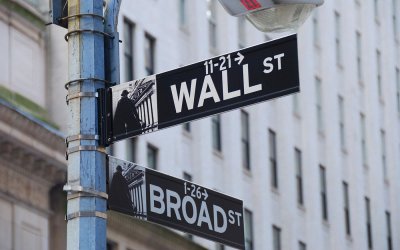The Dow Jones Industrial Average (DJIA) is a stock market index containing 30 US large-cap blue chip companies from various industries. On Wall Street, the index is also known as the Dow Jones, the Dow 30, or simply the Dow. And it’s one of the oldest stock market indices in the world.
It was founded by Charles Dow, Edward Jones, and Charles Bergstresser in 1896, starting off with just 12 industrial companies trading in its initial launch. The list included American Cotton Oil, American Sugar, American Tobacco, Chicago Gas, Distilling & Cattle Feeding, General Electric, Laclede Gas, National Lead, North American, Tennesee Coal & Iron RR, US Leather, and United States Rubber.
Today, the Dow contains a whole new roster of companies, with General Electric being the last to be replaced by Walgreens Boots Alliance in 2018.
Unlike other indices, such as the S&P 500 or FTSE 100, the Dow is a price-weighted index. Consequently, even though it contains 30 of what are considered the most influential businesses in the United States, many analysts view it as a poor representation of the US economy compared to other indices.
How does the Dow Jones work?
As previously said, the Dow Jones Industrial Average is a price-weighted stock market index. Therefore the weighting of each of its constituents is based on share price and not the usual market capitalisation. The level of the index is determined by summing up the total value of all its constituents’ stock prices and then dividing it by a metric called the Dow Divisor.
Much like the S&P 500, the divisor factor is revised regularly. It exists to normalise the index’s level during certain corporate events such as an acquisition, merger, stock split, spinoff, and share buybacks.
Another purpose for the Dow Divisor is to prevent index manipulation by businesses. When a company executes a share buyback scheme, it causes its market capitalisation and, therefore, share price to increase. As companies with the highest share prices have the highest weighting in the Dow Jones, this would cause index funds to increase their stake, pushing the stock price up even further in an artificial and unsustainable cycle.
The divisor factor and constituents are viewed every quarter on the third Friday of March, June, September, and December. Companies can be added and removed based on the discretion of S&P Dow Jones Indices, a subsidiary of S&P Global Inc, which manages the index.
Since its launch, the index has been modified nearly 60 times. The most recent change occurred on 31 August 2020. Amgen, Honeywell International, and Salesforce.com replaced Exxon Mobil, Pfizer, and Raytheon Technologies.
Criteria for joining the Dow Jones
Unlike the S&P 500 or FTSE 100, which consist of the largest businesses in the US and UK, respectively, inclusion into the Dow Jones Industrial Average is entirely up to S&P Dow Jones Indices.
There are no strict criteria for being added, and few companies get the opportunity, given the limited size of the index. However, a few basic requirements include:
- A firm needs to be large and well-respected.
- A company needs to have its headquarters within the United States.
- The business must be publically trading on either the New York Stock Exchange or Nasdaq Exchange.
Top 10 Dow Jones Industrial Average stocks
Below are the top 10 Dow Jones stocks in order of share price and, therefore, weighting as of 27 January 2023.
| Rank | Company | Ticker | Sector |
|---|---|---|---|
| 1 | UnitedHealth Group | UNH | Healthcare |
| 2 | Goldman Sachs Group | GS | Financials |
| 3 | Home Depot | HD | Consumer Discretionary |
| 4 | McDonald’s Corporation | MCD | Consumer Discretionary |
| 5 | Caterpillar | CAT | Industrials |
| 6 | Amgen | AMGN | Healthcare |
| 7 | Microsoft Corporation | MSFT | Technology |
| 8 | Visa | V | Financials |
| 9 | Boeing Company | BA | Industrials |
| 10 | Honeywell International | HON | Industrials |
What is the average return on the Dow Jones?
The Dow Jones Industrial Average was first launched in 1886 at a price level of 40.94. As of January 2023, the index now stands at around 34,100. Therefore the average return of the index over the 137-year period equals 83,192%.
As impressive as that sounds, the return is, in fact, fairly mediocre. On an annualised basis, it’s the equivalent of 5.03%, roughly half of what the S&P 500 has historically delivered. But the historical performance of the index changes depending on which time frame an investor is using.
| Time Frame | Total Return | Annualised Total Return |
|---|---|---|
| Last 50 Years | 3,890.02% | 7.65% |
| Last 40 Years | 2,597.21% | 8.59% |
| Last 30 Years | 804.35% | 7.62% |
| Last 20 Years | 224.80% | 6.07% |
| Last 10 Years | 104.84% | 7.43% |
| Last 5 Years | 45.55% | 7.80% |
The companies within the Dow also pay a modest amount in shareholder dividends. And as of January 2023, the dividend yield on the index stands at approximately 1.88%.
Dow Jones vs other indices
The Dow Jones Industrial Average is not the only US stock market index. Others in the United States include the S&P 500 and Russell 2000. Another popular index from the United Kingdom is the FTSE 100. But how do these compare?
Dow Jones vs FTSE 100
The FTSE 100 is very different from Dow Jones. It contains the largest 100 companies listed on the London Stock Exchange weighted by market capitalisation. By comparison, the Dow is weighted based on share price and has only 30 companies selected by different criteria.
In terms of performance, the FTSE 100 has historically delivered slightly higher returns than the Dow, with an average annual total gain of 7.15% while also remaining less volatile.
Dow Jones vs S&P 500
Unlike the Dow Jones, the S&P 500 is a market cap-weighted stock index that contains the largest 500 companies listed on US stock exchanges. Historically the S&P 500 has outperformed the Dow by a significant margin. However, this has come at the cost of significantly higher volatility.
Dow Jones vs Russell 2000
The Russel 2000 is another market capitalisation-weighted stock index that contains 2,000 small-cap companies. As such, the index is far more prone to volatility than the Dow. In the 2022 stock market correction, the Russell 2000 dropped by as much as 21% versus the Dow’s smaller decline of 8%.
Dow Jones vs NASDAQ 100
Nasdaq 100 is a market cap-weighted stock index of the 100 largest non-financial companies listed on the Nasdaq stock exchange. The index primarily concentrates on technology stocks, allowing it to outperform the Dow Jones significantly over the last five years. However, this also comes paired with substantially higher volatility.
Is the Dow Jones a good investment?
As previously stated, the Dow Jones Industrial Average presents an imperfect picture of the US stock market due to its limited scope. However, its components are well-established companies and provide decent returns for investors. And investors tracking the index by investing in an exchange-traded fund or mutual fund have reaped the benefits over the years.
But does that make it a good investment? It ultimately depends on an investor’s investment goals, risk tolerance, and time horizon. The S&P 500 has historically generated superior returns, but this comes at the cost of added volatility that not everyone is comfortable with.
Dow Jones index sector weighting
| Sector | 27 January 2023 |
|---|---|
| Healthcare | 22.60% |
| Financials | 20.73% |
| Consumer Discretionary | 18.79% |
| Industrials | 15.48% |
| Technology | 14.93% |
| Energy | 3.65% |
| Consumer Staples | 1.89% |
| Materials | 1.13% |
| Communications | 0.78% |
List of all Dow Jones companies
| Ticker | Company | Sector |
|---|---|---|
| UNH | UnitedHealth Group Incorporated | Healthcare |
| GS | Goldman Sachs Group Inc. | Financials |
| HD | Home Depot Inc. | Consumer Discretionary |
| MCD | McDonald’s Corporation | Consumer Discretionary |
| CAT | Caterpillar Inc. | Industrials |
| AMGN | Amgen Inc. | Healthcare |
| MSFT | Microsoft Corporation | Technology |
| V | Visa Inc. Class A | Financials |
| BA | Boeing Company | Industrials |
| HON | Honeywell International Inc. | Industrials |
| TRV | Travelers Companies Inc. | Financials |
| CVX | Chevron Corporation | Energy |
| JNJ | Johnson & Johnson | Healthcare |
| CRM | Salesforce Inc. | Technology |
| AXP | American Express Company | Financials |
| AAPL | Apple Inc. | Technology |
| WMT | Walmart Inc. | Consumer Discretionary |
| PG | Procter & Gamble Company | Healthcare |
| JPM | JPMorgan Chase & Co. | Financials |
| IBM | International Business Machines Corporation | Technology |
| NKE | NIKE Inc. Class B | Consumer Discretionary |
| MMM | 3M Company | Industrials |
| DIS | Walt Disney Company | Consumer Discretionary |
| MRK | Merck & Co. Inc. | Healthcare |
| KO | Coca-Cola Company | Consumer Staples |
| DOW | Dow Inc. | Materials |
| CSCO | Cisco Systems Inc. | Technology |
| VZ | Verizon Communications Inc. | Communications |
| WBA | Walgreens Boots Alliance Inc. | Consumer Staples |
| INTC | Intel Corporation | Technology |
The bottom line
Though the Dow Jones is widely seen as an inaccurate representation of the US stock market on Wall Street, it still comprises 30 well-established companies. This makes it a popular index among more conservative investors keen on investing in some of the most well-regarded businesses in the United States.
Discover market-beating stock ideas today. Join our Premium investing service to get instant access to analyst opinions, in-depth research, our Moonshot Opportunities, and more. Learn More
This article contains general educational information only. It does not take into account the personal financial situation of the reader. Tax treatment is dependent on individual circumstances that may change in the future, and this article does not constitute any form of tax advice. Before committing to any investment decision, an investor must consider their individual financial circumstances and reach out to an independent financial advisor if necessary.





